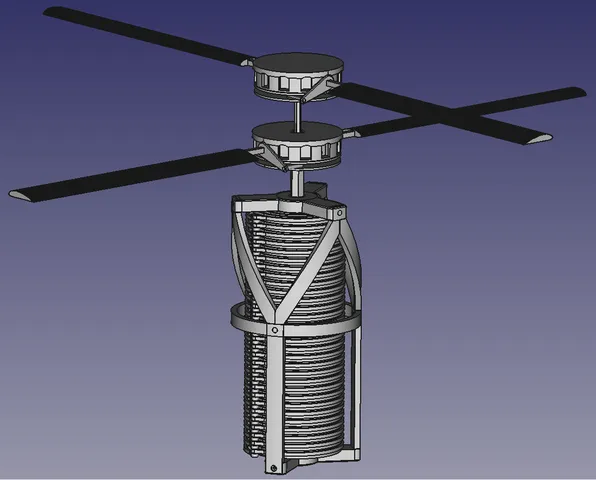
Spring Powered Coaxial Rotorcraft
prusaprinters
NOTE: this is not currently flying. I am going to totally redesign it optimized for a better power to weight ratio sometime in the future. This is my submission for the “Make it Fly” contest. It is powered by a total of 60 large 12cm-diameter springs with a surprising amount of torque, connected in series for a total of almost 200 rotor turns. Since the springs are not geared down, this will be by far the most powerful 3D-printed spring-powered flying machine I am aware of. Other similar designs are lightweight and use a single spring geared way down to provide an adequate number of turns, but I decided to go with a large-scale, high-powered design to stand out, and to show what 3D printed designs can really be capable of. It uses a combination of PLA and Polymaker LWPLA to mitigate the weight.In addition to the 3D printed parts, you will need:6204 bearing x2608 bearing x1M3x12 bolt and nut x11EpoxyCA glueWax paperLarge binder clipsPTFE lubricantOf course, you can substitute any of the hundreds of 3D printed bearings on the internet, but I am using steel bearings for now since I don't want to loose any spring power to friction and I don't think the added weight will be much of an issue. Filament/nozzle schedule:PLA 0.8mm nozzle:Lower Inner AxleUpper Inner AxleAll SpringsSparsPLA 0.4mm nozzle:Outer AxleAll Spring ConnectorsInner Axle ConnectorInner Axle Bearing ConnectorInner Axle SheathPitch ArmsPitch Arm PinsSpar NutsLWPLA 0.8mm nozzle:Top & Bottom Spring PlatesHelical BracesTransverse BracesVertical BracesAll Brace PinsAll Rotor Head ComponentsLWPLA 0.4mm nozzle:All RotorsStoppers Changelog:4/15/23: Modified the spring top plate and transverse brace so that they have the brace pegs built-in, this eliminates printing the pegs and makes gluing the spring cage together much easier. Added a “cast” for gluing the rotor blades- this keeps the inner and outer rotor blades aligned and presses the spar into the blades as the epoxy dries.Changed the print orientation of the rotor blades due to excessive warping and failed prints. They now print horizontally on the print bed rather than vertically. This is not optimal layer direction aerodynamically, but it is better layer direction for the strength of the rotor, and they come out surprisingly smooth.
With this file you will be able to print Spring Powered Coaxial Rotorcraft with your 3D printer. Click on the button and save the file on your computer to work, edit or customize your design. You can also find more 3D designs for printers on Spring Powered Coaxial Rotorcraft.
